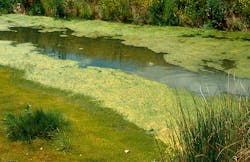WASHINGTON -- The U.S. Environmental Protection Agency (EPA) took another step to address the environmental challenges posed by harmful algal blooms (HABs) by announcing $6,487,188 in funding to seven institutions to research how to prevent and control HABs using current and new technologies. With today’s announcement, EPA under President Trump has awarded more than $8.5 million in grant funding to research methods to reduce excess nutrients in watersheds.
“Harmful algal blooms are a serious and persistent problem across all 50 states that can have severe impacts on human health, the environment, and the economy,” said EPA Administrator Andrew Wheeler. “By expanding our knowledge of how to control and prevent the occurrence of these blooms, we can better protect our watersheds—especially our drinking water sources and recreational waters.”
As part of Administrator Wheeler’s focus on addressing our nation’s pressing water issues, preventing and mitigating excess nutrients in our waters, and the HABs that they can create is one of EPA’s highest water quality priorities. In 2020 alone, EPA has awarded Small Business Innovation Research funding to companies developing technologies to better detect HABs, released draft nutrient criteria for lakes and reservoirs, and announced an award of more than $2 million in funding to help states implement plans to that reduce excess nutrients and improve water quality in the Mississippi River/Atchafalaya River Basin. Today’s award marks the largest research grant to date to support a nation-wide effort to prevent and control HABs.
The seven recipients receiving today’s funding through EPA’s Science to Achieve Results (STAR) Program include:
- Oklahoma State University, Stillwater, Okla., to create a technology that will absorb nutrients from agricultural runoff to be repurposed as a time-release fertilizer for future agricultural use, which will reduce environmental and financial costs associated with fertilizer production and excess nutrient loading of agricultural watering ponds and downstream waters.
- San Jose State University Research Foundation, San Jose, Calif., to demonstrate the effectiveness of farm runoff treatment systems in reducing nutrient discharges to coastal waterways, and to provide a blueprint for scaling-up treatment systems within two key agricultural watersheds of Monterey Bay.
- University of Idaho, Moscow, Idaho, to develop and accelerate three innovative water treatment technologies that can remove phosphorus to levels that help restore algae-impacted waters.
- University of Illinois at Urbana-Champaign, Champaign, Ill., to produce and scale up an innovative treatment system to effectively capture excess nutrients from subsurface drainage in agricultural fields, recycle the nutrient-captured biochar as a slow-release fertilizer, and keep nutrients in the closed agricultural loop.
- University of South Florida, Tampa, Fla., to develop an assessment framework to optimize the implementation of excess nutrient treatment technologies and reduction strategies guided directly by the ecological response of the watershed for effective HABs control.
- Washington University, St. Louis, Mo., to create a robust, environmentally sustainable, and widely applicable excess nutrient removal/recovery technology.
- Water Research Foundation, Alexandria, Virginia, to improve full-scale applications of shortcut excess nitrogen removal processes in mainstream wastewater treatment systems.
Through the development of new technologies and the optimization of existing technologies and best management practices, these projects will assist in reducing excess nutrients that enter the Nation’s waterways and support EPA’s goal to reduce the occurrence of HABs across the United States.



